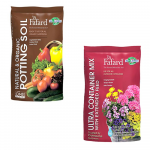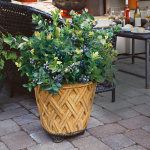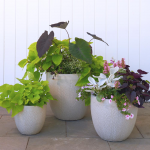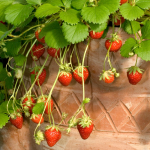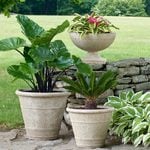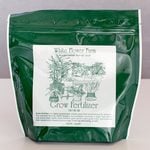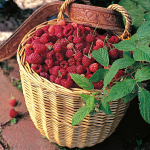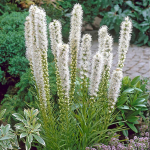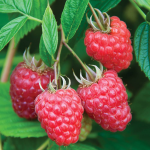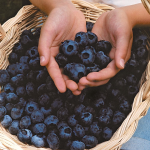Product Details
We are pleased to offer Raspberry Shortcake® from Bushel and Berry®, a dwarf Raspberry bush with full-size berries. Plants thrive in containers as well as in your garden and require no staking. The carefree, compact shape means no big garden spaces are required. You'll love harvesting the delicious sweet berries right from your patio. Plus there are no thorns to get in your way. This dwarf red Raspberry sends out lots of new canes each spring that produce more midseason fruit every year. Raspberry Shortcake® grows to a height of 3', making it perfect for compact spaces and container gardening. Plants are self-pollinating. 'NR7' PP 22,141
Formerly known as BrazelBerries®, these self-pollinating varieties fare as well in containers as in the ground. The berries are anything but dwarf, and once the plants are established, they will fruit reliably for years.
Growing Bushel and Berry™ Raspberries in containers:
Bushel and Berry® bushes are dwarf plants that require no trellising or staking. Upon arrival, replant in a 12–16″ container using good-quality potting soil. Place the container outdoors in full sun for the growing season. As your plant matures, you will likely need to put it in a 20–24″ diameter container. Your plant will start producing more fruit in the second year.
Fertilizing. Fertilize your plants in early spring and again in midsummer with a balanced, water-soluble fertilizer (such as 18-18-18).
Pruning. Simply let your plant go dormant in the winter. In early spring, you should start to see new green sprouts coming up from both soil and on some of the old canes. The sprouts from the ground will become canes that will fruit the following year. Old canes with new growth emerging should fruit this year. Leave all the new shoots from the ground and old canes that have green leaves emerging. Cut all the dead canes with no new growth at ground level.
Wintering over. In colder climates (Zone 5), you can overwinter plants in their containers by storing them in a sheltered, unheated area such as a garage or shed once the leaves drop in fall. Be certain the soil is moist when the plant is brought under cover, and water very sparingly during the winter. Once every 6 weeks is generally sufficient. The intent is for the plant to go as dormant as possible. In spring, bring them outside when temperatures remain above 25°F and place in full sun.
In warmer climates where freeze-thaw cycles occur, store plants on a protected porch. Where freezing is not a concern, plants can remain outdoors in containers and enjoyed year round.
Growing Bushel and Berry® Rasberries in the ground:
Choose a location in full sun (at least 6 hours of direct sun each day) with rich, well-drained soil, and then dig a hole that will generously accommodate the plant's root ball. Gently remove the plant from its pot and place into the hole so that the top of the root ball is level with the surrounding soil. Then push soil back into the hole around the plant and press firmly with your hands to eliminate air pockets and establish good soil contact. A gentle but thorough watering will further settle the soil around the plant.
Raspberries need at least 1” of water per week, especially during the first season after planting. If the amount of rainfall is less than this, water deeply at the base of the plants once a week. Keep moisture off the leaves to discourage disease. Fertilize the plants 4–6 weeks after planting, with a timed-release fertilizer. In subsequent years, fertilize in early spring and again in early July. Adding 1–2” of compost or well-rotted manure as a side dressing around each plant in spring will improve the soil's texture and add nutrients.
Shipping
HOW PLANTS ARE SHIPPED
The size of the plants we ship has been selected to reduce the shock of transplanting. For some, this means a large, bareroot crown. Others cannot travel bareroot or transplant best if grown in containers. We ship these perennials and annuals in 1 pint pots, except as noted. We must point out that many perennials will not bloom the first year after planting, but will the following year, amply rewarding your patience. We ship bulbs as dormant, bare bulbs, sometimes with some wood shavings or moss. Shrubs, Roses, vines, and other woody plants may be shipped bareroot or in pots. The size of the pot is noted in the quick facts for each item.
WHEN WE SHIP
We ship our bulbs and plants at the right time for planting in your area, except as noted, with orders dispatched on a first-come, first-served basis by climate zone. We also ship a wide range of containers and planters, tools, supplies, fertilizers, garden wear, garden decor items, as well as indoor decorations like wreaths and dried bouquets when available. Estimated dates for shipping are indicated in the green Shipping Details box for each item. Please supply a street address for delivery. Kindly contact us with two weeks notice, if you'll be away at the expected time of delivery.
OUR GUARANTEE
We guarantee to ship plants that are in prime condition for growing. If your order is damaged or fails to meet your expectations, we will cheerfully replace or refund it. Please contact our Customer Service Department at 1-800-503-9624 or email us at [email protected]. Please include your order number or customer number when contacting us.
Reviews
Average Customer Rating:
 (36 Reviews)
Write a Review
(36 Reviews)
Write a Review
Sort by:
Plentiful in Year 2! 
Rita Pin Ahrens from Washington, DC
28 of 29 people found this review helpful. Do you? yes no Certified buyer
NYC Terrace Gardener 
A viewer from New York, New York
16 of 16 people found this review helpful. Do you? yes no Certified buyer
Severely disappointed 
A viewer from Yarmouth, Maine
Growing guide
Growing Bushel and Berry® Blackberries and Raspberries in containers:
Bushel and Berry® plants are dwarf bushes that require no trellising or staking. Upon arrival, replant in a 12–16″ container using good-quality potting soil. We recommend Fafard Complete Container Mix with water-retaining crystals that help reduce stress in the hot summer months. Place the container outdoors in full sun for the growing season. As your plant matures, you will likely need to put it in a 20–24″ diameter container. Your plant will start producing more fruit in the second year.
Fertilizing. Fertilize your plants in early spring and again in midsummer with a balanced, water-soluble fertilizer (such as 18-18-18).
Pruning. Simply let your plant go dormant in the winter. In early spring, you should start to see new green sprouts coming up from both soil and on some of the old canes. The sprouts from the ground will become canes that will fruit the following year. Old canes with new growth emerging should fruit this year. Leave all the new shoots from the ground and old canes that have green leaves emerging. Cut all the dead canes with no new growth at ground level.
Wintering over. In colder climates (Zone 5), you can overwinter plants in their containers by storing them in a sheltered, unheated area such as a garage or shed once the leaves drop in fall. Be certain the soil is moist when the plant is brought under cover, and water very sparingly during the winter. Once every 6 weeks is generally sufficient. The intent is for the plant to go as dormant as possible. In spring, bring them outside when temperatures remain above 25°F and place in full sun.
In warmer climates where freeze-thaw cycles occur, store plants on a protected porch. Where freezing is not a concern, plants can remain outdoors in containers and enjoyed year round.
Growing Bushel and Berry® Blackberries and Raspberries in the ground:
Choose a location in full sun (at least 6 hours of direct sun each day) with rich, well-drained soil, and then dig a hole that will generously accommodate the plant's root ball. Gently remove the plant from its pot and place into the hole so that the top of the root ball is level with the surrounding soil. Then push soil back into the hole around the plant and press firmly with your hands to eliminate air pockets and establish good soil contact. A gentle but thorough watering will further settle the soil around the plant.
Blackberries and Raspberries need at least 1” of water per week, especially during the first season after planting. If the amount of rainfall is less than this, water deeply at the base of the plants once a week. Keep moisture off the leaves to discourage disease. Fertilize the plants 4–6 weeks after planting, with a timed-release fertilizer. In subsequent years, fertilize in early spring and again in early July. Adding 1–2” of compost or well-rotted manure as a side dressing around each plant in spring will improve the soil's texture and add nutrients.


